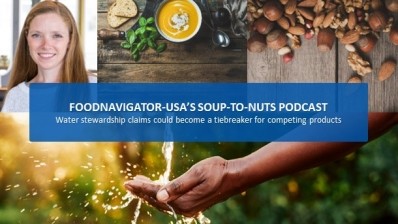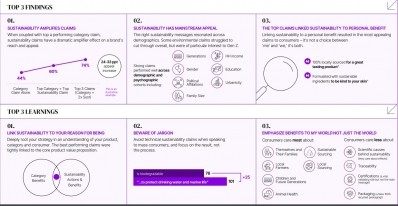Building a net zero, water secure future in food & beverage
Water stewardship rises amid scarcity concerns, consumer interest in conservation
According to the Food and Agriculture Organization, in the coming year two-thirds of the global population will grapple with water stress and many will suffer severe life-threatening shortages.
At the Grundfos Industry Sustainability Summit in Lenexa, Kan., last week, ingredient suppliers, brand manufacturers and industry players across the value chain brainstormed water conservation solutions for the food and agriculture industry, given it accounts for 70% of all freshwater withdrawals.
Among the strategies to better manage water are reducing withdrawals by updating systems and equipment to be more efficient, reusing water where possible and reducing pollutants to help protect and restore water availability – all of which require collaboration and strategic investment to succeed.
Recycling water reduces withdrawals without compromising safety
Using less water is the simplest solution to address water scarcity, but as Grundfos Regional Sales Manager Colin Cummings explains this is not an option for most for most food and agriculture industry players. Rather, he says, a more realistic solution is to use water more efficiently, in part by recycling and reusing as much as possible before it “goes down the drain.”
Water use in food and beverage manufacturing concentrates heavily around sanitation, which means companies often cannot reduce water usage without compromising safety, Cummings explains.
“The answer is to use the water in a more efficient way, and one of those ways that we can do that is through water reuse. So, instead of taking an application that utilizes the water and then it goes down the drain and then it goes down to the water treatment facility,” manufacturers can capture, treat and reuse that water elsewhere in their factory, he explained.
While he says many consumer production facilities are interested in reusing water, many do not know where to start – which is where Grundfos can help by following the “water path” to identify where equipment updates, such as the water pumps it makes, could help, said Cummings.
“We can actually put in place sensors and controls and variable frequency drives to speed up, slow down the pumps and even stop the pumps when water is not needed downstream. And this obviously reduces the water usage, energy consumption, and also life cycle of the actual pump itself,” he explained.
He added Grundfos’ diverse portfolio can help at every point in the water path.
“We can bring it out of the well for you, bring it out of the river for you, bring it into the facility, pressurize it throughout the facility, treat the water if needed as it is going through the multiple applications and then also dispose of the water from a solids handling perspective at the end,” he said.
Reusing water – even if it means investing in new equipment – can save companies money and facilitate expansion that may not otherwise be possible, explained Paul Bowen, a water and sustainability expert with GHD and co-founder of the Beverage Industry Environmental Roundtable.
“Water is such a scare resource. It is a renewable resource, but it is scarce in many areas, and being able to make it into a circular pattern within your own business really … gives you more opportunities in your business. Many of the cases that I have dealt with throughout my career, have dealt with businesses that could not expand because of water scarcity,” he said.
“So, if you can recycle it, you can reuse it, if you can change processes so that they use less water, then you now have more water for your product, more water for production. Hence you can grow your business,” he added.
How might consumers perceive water reuse?
While reusing water holds significant potential, concern about negative consumer perception is a major roadblock – but it does not have to be.
Many food and beverage companies restrict water reuse to non-product contact use, such as for mechanical operations, because they are worried how the consumer would respond if “they got a little too aggressive with how to tighten up that water,” E4E Solutions President and CEO Josh Long told FoodNavigator-USA.
“You do not want to be the first one to reuse water that goes to making a juice or something like that,” he added, noting he has clients whose reused water is certified as potable and yet they are still nervous to use it beyond the mechanical room or for cleaning.
“Water reuse sometimes carries a dirty name,” acknowledges Cummings. But he suggested explaining the practice to consumers as recycling might strike a more positive note because “when people recycle, they feel good about themselves.”
Bowen agreed, noting when water reuse is properly explained to consumers it could build loyalty because most consumers want to support companies and brands with sustainability initiatives.
Water stewardship solutions cannot be one size fits all
To be effective, water stewardship practices – including reusing water – must be tailored based on water availability, community requirements and business goals, all of which are complicated by climate change.
Cargill’s Sustainability Director Peter Dahm explains increasingly frequent downpours and deepening droughts due to climate change mean some places have too much water while others have too little. And nearly all, he adds, struggle with pollution to some degree.
In addition, not all aspects of the value chain are as water intensive as others, he said. For example, agriculture uses much more water than most facilities and so when creating and adopting water stewardship best practices companies should consider the amount of water used and the water stress in their region.
As such, he said, Cargill is prioritizing action where it is needed most and by 2030 intends to have water stewardship practices at all 72 priority facilities.
Regenerative agriculture can reduce water requirements, potential pollutants
One way Cargill is improving water stewardship within agriculture is by encouraging farmers to adopt regenerative agriculture practices, such as no- or low-till and cover crops, which can help the soil “act like a sponge” and better maintain moisture so less additional water is necessary, said Dahm.
These practices also reduce input requirements, which can reduce the risk of water pollution, he added.
“One of the major pollutants into the water table is from fertilizer, and so if you are able to create a soil structure where you do not need to apply as much fertilizer, there is less fertilizer that is going to be leaching into the water table,” he explained.
He added, through regenerative agriculture and other efforts, Cargill aims to restore 600 billion liters of water and reduce by 5,000 metric tons water pollutants in water stressed regions by 2030.
Consumer interest in water conservation on the rise
Water stewardship is not as front of mind for consumers as carbon emissions, but awareness is emerging and proactive companies are acting now to engage with socially conscious shoppers around water.
According to Innova Marketing Insights, three-quarters of consumers believe companies should use resources more carefully and 38% of US and European consumers seek water usage and ocean protection claims. Whole Foods Market also added water conservation to its 2024 top trends list.
In response, food and beverage brands made 40% more water claims on pack in the last four years, according to Innova.
Among those interested in marketing claims related to their water stewardship efforts was a dairy farm in Modesto, Calif., with which Long said he worked.
He predicts marketing around water stewardship will become more common but cautioned it might take time before it is mainstream.
This means companies interested in enhancing water conservation – and related marketing – can do so now without feeling behind the curve, Bowen said.
“If you have not started yet, you are not behind. You can rapidly catch up to where everybody else is,” by reaching out to leaders in the space, such as the Water Environment Federation, Water Use Association and the Food and Beverage Environmental Conference.
“I have never found a person in this space who does not want to share their knowledge with others,” he added. “It is very, very much like a family and they are very willing to share and help.”














